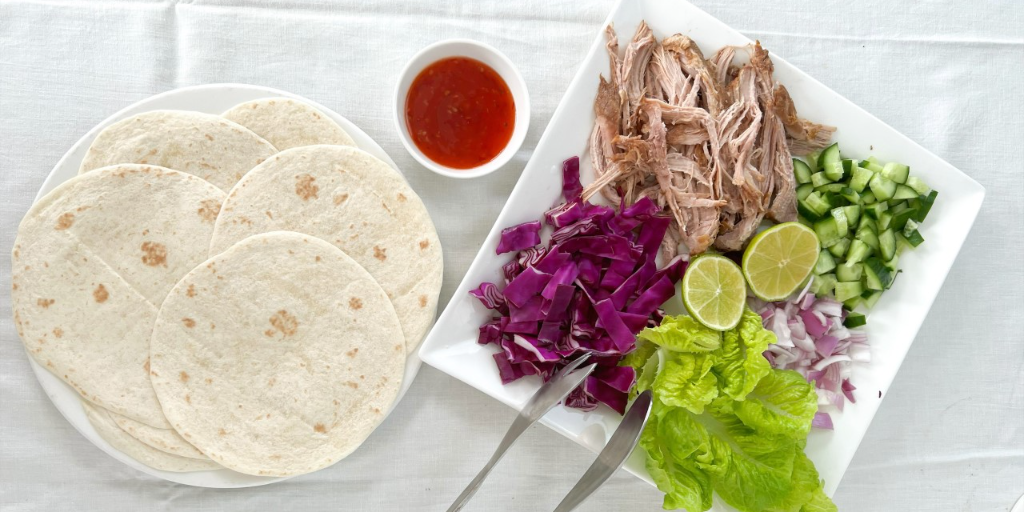Family-style meals

Are family-style serves the secret to calmer mealtimes?
Feeding children can be challenging at the best of times but if mealtimes have become a constant battle in your house, it’s worth considering serving meals ‘family-style’. This approach to feeding families can help reduce the stress for everyone in the house and bring back calm to mealtimes.
So… what are ‘family-style’ meals?
Any meal where food is put out for everyone to help themselves is a ‘family-style’ meal. Think Christmas lunch or birthday parties! Everyone gets an empty plate and serves themselves whatever they would like. It’s a way of eating that’s been used for centuries all over the world. It’s a strategy used by nutrition experts to help reduce the stress of mealtimes and support children to become independent, competent eaters.
Why serve meals like this?
If your family is having plated meals and children are happily eating, or at least willing to try, most things on their plate then read no further. If mealtimes have become a battleground or a time when emotions run high. And There is heavy negotiation about how many bites are needed or what is enough dinner to ‘earn’ dessert, then it’s time to consider family-style meals. Your child’s eating is unlikely to improve when there is tension at mealtime. Changing the way you serve meals helps re-set the mealtime dynamic and clarify the roles of the parent and child in feeding. At the very least, it will return some calm to the dinner table which is usually a relief for everyone. Read more here about what you and your child are responsible for at mealtimes.
How to start family-style meals
Your child has probably already had some experience with family-style serving. Maybe for a special occasion or when they have been able to choose whatever they want from what’s offered without any rules about what they should eat or how much. It may be that snack times are served this way, with two or three options for everyone to help themselves.
Transitioning to family-style meals doesn’t have to create more work, be more complicated or more expensive. It’s a change in the way food is presented rather than a change to what is offered. Instead of plated meals for each family member, food is put out for everyone to serve themselves.
Any meal or snack can be served family-style. The transition can be gradual. It doesn’t have to be all meals and snacks at once. Evenings are often a busy time for families so it may be easier to transition to family-style meals with breakfast or snacks or on weekends. Meals that work particularly well for family style servings are those that can be ‘deconstructed’. Include at least one food that your child will usually eat then give everyone a plate and they choose what goes on it. When starting family-style serving, keep it simple and consider no-cook foods: bread/crackers, cheese slices, dips, cold meat and cut up fruit and veggies. That way, you can get the benefit of calmer mealtimes while everyone gets used to a new way of eating. See our Ginger & Pork Tacos recipe below and more recipes here.

What if my child eats absolutely nothing at mealtimes!
If the goal of transitioning to family-style servings is to achieve calmer, more enjoyable mealtimes. It’s quite possible that your child will choose to eat nothing at all for but if mealtimes are calmer, that’s something worth savouring! It’s tempting to encourage children to eat more or less, especially if you are worried about their growth or nutrition, but it’s important to resist the urge and keep mealtime peace as your initial goal. Once calmer mealtimes and family-style servings are established it will be easier to make other changes and work towards increased variety. Although they won’t be the solution for every feeding issue, they are a simple and effective way to stop mealtime battles.
Children’s appetites are highly variable and ‘picky eating’ is an expected developmental stage so it can be helpful to think about what your child eats over a few days or across the week, rather than for one meal or snack. For more information HFFL related information see: here
If you are concerned about your child’s food intake, eating behaviours, growth or nutrition-related health, contact a GP, paediatrician or Accredited Practising Dietitian. Who can provide a comprehensive assessment that considers your child’s medical history, eating patterns including mealtime experiences, physical activity and genetic factors.






